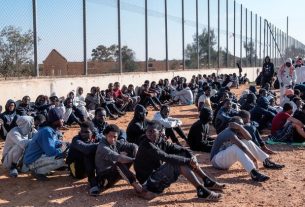As the world grapples with an unprecedented number of forcibly displaced people (FDPs), ranging from refugees to asylum seekers, there is a growing recognition that financial inclusion is a powerful tool in improving their lives. According to Mariam Zahari from the Alliance for Financial Inclusion (AFI), central banks and financial regulators have a crucial role to play in ensuring that FDPs are not excluded from formal financial systems. Through thoughtful and inclusive policy design, regulators can unlock opportunities for these marginalized populations to thrive and contribute to their host countries’ economies.
In her article for the European Microfinance Platform (e-MFP), Zahari outlines four key actions that central banks and financial regulators must take to promote the financial inclusion of FDPs and ensure that their participation in the economy is both sustainable and empowering.
1. Creating Legal and Regulatory Frameworks for Financial Inclusion
The first step in enabling the financial inclusion of FDPs is for regulators to create clear, flexible legal and regulatory frameworks that explicitly include this population. In many countries, FDPs face significant legal and bureaucratic barriers to accessing financial services. Issues like lack of identification, residency status, and uncertainty around the right to work often prevent them from opening bank accounts, obtaining loans, or accessing insurance.
To address these challenges, financial regulators must adapt existing laws and policies to accommodate the realities of displaced populations. This can include allowing alternative forms of identification (such as refugee status documentation or biometric data) to open accounts, providing temporary status documentation, and ensuring that displaced people can access services without the need for long-term residency or a national ID. Furthermore, regulators can encourage financial institutions to develop digital financial products that cater to the unique needs of FDPs, especially those in camps or remote areas.
Inclusive regulatory frameworks would not only ease access to basic financial services but would also encourage financial service providers to innovate in ways that address the needs of this vulnerable group.
2. Enhancing Access to Digital Financial Services
With the increasing use of mobile banking and digital wallets, regulators have a unique opportunity to enable FDPs to access financial services even in challenging circumstances. Digital platforms eliminate many of the physical barriers that prevent displaced people from accessing traditional banking systems, such as distance to physical bank branches or lack of documentation.
Zahari emphasizes that financial regulators should focus on enabling mobile financial services, as they have proven to be effective in connecting displaced populations to the broader financial system. By leveraging mobile money solutions, regulators can enable displaced people to send and receive remittances, access savings, or even apply for microloans—all without needing a permanent address or formal identification. These services can also be used to distribute humanitarian aid directly to displaced individuals, reducing reliance on cash-based assistance and increasing transparency in the distribution process.
Regulators can work with financial institutions to ensure that digital payments are available in areas with poor infrastructure, such as refugee camps, and ensure that mobile financial services are affordable, secure, and accessible to the people who need them most.
3. Promoting Financial Literacy and Education
Financial literacy is key to ensuring that FDPs not only have access to financial services but can also use them effectively. Many displaced people come from communities with limited exposure to formal financial systems. In order to take full advantage of the opportunities that financial inclusion offers, they need to understand how to budget, save, invest, and access credit.
Financial regulators can support the development of financial education programs tailored specifically for FDPs. This could involve partnerships with NGOs, financial institutions, and community leaders to offer workshops, mobile training, or community-based programs that teach the basics of financial management. Additionally, financial literacy campaigns could target key groups such as women, who are often disproportionately affected by displacement and poverty, and youth, who may face additional barriers to financial services.
By equipping FDPs with the necessary knowledge to navigate financial services, regulators can help reduce financial exclusion and enable displaced people to secure their financial futures, whether through savings, investments, or business opportunities.
4. Fostering Partnerships Between Financial Institutions and Humanitarian Organizations
The financial inclusion of FDPs is not solely the responsibility of regulators. In Zahari’s view, a collaborative approach is essential. Financial regulators can play a key role in facilitating partnerships between financial institutions and humanitarian organizations. These collaborations can help ensure that FDPs receive not only access to financial products, but also holistic support in managing their finances and integrating into the local economy.
For instance, regulators can encourage financial institutions to work with NGOs to develop products that cater to the specific needs of FDPs, such as refugee savings accounts, emergency microloans, and affordable insurance products. Humanitarian organizations can help distribute these products and ensure that they reach the people who need them most, while also providing financial education and support.
Furthermore, regulators can promote partnerships between mobile money providers and humanitarian agencies, enabling the rapid distribution of funds for essential services like healthcare, shelter, and education, directly to displaced individuals. These partnerships can also support refugee entrepreneurship by providing displaced people with the necessary tools and resources to start businesses in their new communities.
Conclusion: Financial Inclusion as a Path to Empowerment
As the world faces a growing crisis of displacement, it is more important than ever that central banks and financial regulators play a leading role in advancing financial inclusion for forcibly displaced people. By creating inclusive legal frameworks, promoting digital financial services, enhancing financial literacy, and fostering collaborations between financial institutions and humanitarian organizations, regulators can help empower displaced populations to rebuild their lives with dignity and security.
Mariam Zahari’s insights underscore the fact that the financial sector has a vital role in addressing displacement. Financial inclusion is not just about access to banking services—it’s about enabling displaced people to participate fully in their host economies, become financially independent, and thrive despite the challenges they face.
Through concerted effort and thoughtful regulation, financial regulators can transform the lives of millions of displaced people and provide a powerful mechanism for long-term empowerment.
References:
- Mariam Zahari, “How Financial Regulators Can Empower Forcibly Displaced People to Thrive”, e-MFP Blog (2024).
- Alliance for Financial Inclusion, “Financial Inclusion for Refugees: A Step Toward Empowerment” (2024).
- European Microfinance Platform (e-MFP), “Advancing Financial Inclusion for Refugees and Forcibly Displaced People: The EMA 2024” (2024).



